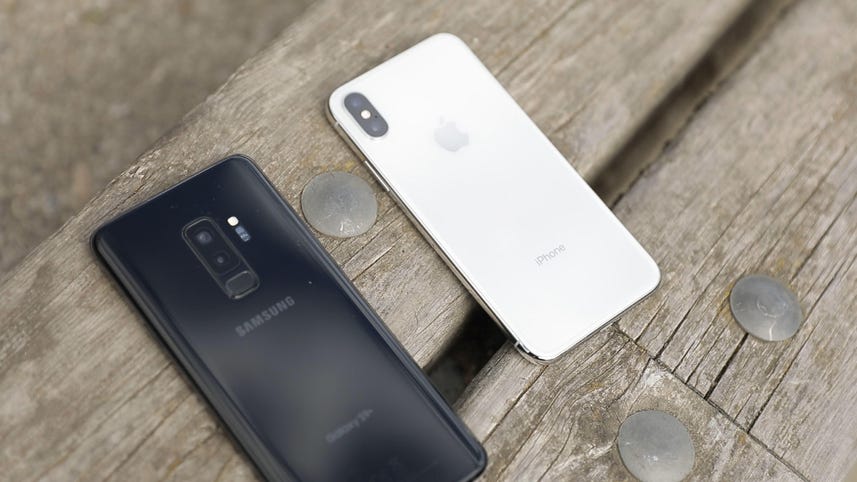
[MUSIC]
Galaxy and iPhone.
It's another battle of the cameras.
Not much has changed from the S8 plus to the S9 plus, but the camera is a different story.
Samsung has raised the bar on smart phone photography with a variable aperture and super slow-mo feature on its S9.
But is it enough to outshine the iPhone 10 and claim the crown as our camera king?
[MUSIC]
I took these giants up to Lake Tahoe in California to see how well we can capture the snowy mountains.
And ideally there is no question these guys are taking incredible photos and videos.
You will slight differences in color template sure in texture depending on the screen you are watching this on but at least to my eyes there is no clear winner.
They both have optical inner stabilization on both lenses And video looks smooth even when I'm pounding up a snowy mountain chasing my pup.
They can both record up to 4K at 60 frames per second, but you'll have to take our word for it because we can't actually play it in 4K.
What's unique about the S9 is that it has a variable aperture.
In low light, it gets wider to let in more light, and in bright light it becomes more narrow.
The S9 can only choose between F1.5 and F2.4, but the fact that it even has the option is a pretty good deal in a phone.
The iPhone's aperture fixed.
So, it's relying on image processing and shutter speed to adjust a different lining conditions.
And, shots look more consistent across the board.
In this lake shot the S9 Plus looks a bit softer while the iPhone's has more contrast and texture.
But in this shot of the snow the S9 has the higher contrast.
The S9 Plus also lets you pick the aperture in pro mode.
Switch between the two and adjust a bunch of other settings to get more out of your shot.
But when you're out and about, you probably don't wanna bother messing around with settings.
And that's one of the problems with the super [UNKNOWN] feature on the S9, it's not exactly straight forward.
And 960 frames per second, it is much slower than the 240 frames per second on the iPhone 10, But it doesn't shoot in full HD, and it doesn't shoot the entire clip at this frame rate.
But when it does get it right, the S9's is way more dramatic than anything you'll get on the iPhone.
The iPhone X is just point and shoot, that's it.
The entire clip can be in slow motion if you want it to be because you can even edit it later.
The S9 also has this option but it's buried in the settings.
[MUSIC]
And what about the other lens?
Both phones have a second telephoto lens with similar specs for optical, zoom and blurred background portraits.
At 2x, both produce great results.
But if you zoom in, you'll notice the S9 Plus is sharper.
The iPhone 10 has portrait mode and the S9 Plus has focus Similar to what we saw in the Note 8.
And neither is perfect at figuring out what to blur, but in general they both do a good job at portraits.
Colors on the iPhone seem cooler, and the shot is more true to life because it retains a lot more detail in the face, while the S9's appears to be more flattering because it makes faces brighter and evens out shadows and skin tone.
But sometimes all the retouching can backfire.
And in this photo the S9 applied the same filter on my face as it did to my son, and while he looks fine, I look yellow.
And it you're a fan of selfies both phones have portrait mode on the front facing cameras as well.
The iPhone X has a depth sensing camera which is slightly better at figuring out what to blur in the shot, but they're using software, so They're not as great as using the main camera.
The S nine also let's you do a wide angle selfie.
[MUSIC]
But for video, it's the opposite and the S nine gets a little too close for For comfort.
[MUSIC]
When the sun goes down is when the S nine plus really shines.
The wider aperture allows it to let in more light without sacrificing detail and picture quality.
It did well considering how dark it was but in this shot of the lake, there's no competition.
The shot on the S nine looks smoother and brighter while the iPhone's looks darker and a bit granier.
And once you zoom in it's even more obvious.
The S9 is still able to capture some detail in the trees and the smoke out in the distance while the iPhone's looks like an impressionist's painting with blobs.
And this applies to videos as well but the differences are not as great.
Photographing subjects in bad lighting is tough on both especially if there's movement.
The S9 Plus still looks brighter but it's blurry and the color temperature seems off.
Same goes for video, color on the iPhone seem more true to life but the shot in general looks darker.
But when the subject is still like this shot of Charlie, the S9 pulls ahead, and for food's shot it's impressive even in this dimly lit restaurant, it managed to capture a lot of texture in the onion.
Look both have their strengths and weaknesses, the iPhone is reliable and consistent if you're looking for a camera that does all the work for you.
The S9+ though is the clear winner in low light photography, and it gives you much more control over your shot, if you're willing to work for it, so really the best one here depends on what you want in a camera.
[MUSIC]